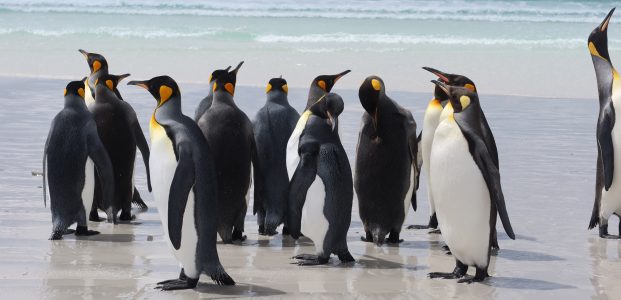Reading: Longtitude (Dava Sobel) (finished) Finn Family Moomintroll (Tove Jansson) (finished) Forever Home (Graham Norton)
Weather: Wind – what else? Some rain and some sun which we have to be careful of as there is a shortage of ozone round here.
Thought for the day(s): Do penguins know just how cute they are?
Wildlife headcount: King penguins, magellanic penguins and gentoo penguins – probably some other stuff as well, but the penguins steal the limelight….
General
While the crew do various jobs and bits of maintenance, we are free to explore the Falklands. This is easier said than done as they are huge – more than the size of Wales. The biggest islands are East Falkland (where Stanley is) and West Falkland but there are another 776 smaller islands as well. The islands are self-governing but their defence and foreign affairs are managed by the UK so they are defined as a British Overseas Territory. The islands were first sighted by a ship called the Desire and the motto on the Falklands flag – Desire the Right – comes from this.
The islands have had various names, but the current name comes from the original name comes from the first (known) landing on the islands by a captain called John Strong in 1690. He was mainly interested in the islands as a source of water and a way to vary his crew’s diet, but he named the sound between West and East Falkland Falkland Sound. This was in honour (!) of Antony Cary the 5th Viscount Falkland who was the main sponsor of his expedition. The name was extended to all the islands by another privateer – Woodes Rogers. He never landed on the islands, but in his journal on December 24th 1708 he referred to the whole island group as the Falklands. The name has stuck – if you are British! A decade later the French arrived and called the islands Les Malouines – after their home port of St. Malo. The Argentinian name – Las Malvinas – derives from this French name.
The initial history of the islands could just as well be a history of whaling and sealing as they quickly became a base for this. There are still various wrecks around the shores of Stanley. Walking along the shore to Surf Bay (on the eastern shore of the island) took me past the Golden Chance and the Gentoo. These two ships were steam drifters and were originally built in Lowestoft to fish for herring in the North Sea. In the Dockyard Museum in Stanley is a picture of the Golden Chance leaving Wivenhoe in 1949 to take part in sealing operations and the Gentoo came out a few years later. They are now slowly returning to their constituent parts at the entrance to an area called the Canache.
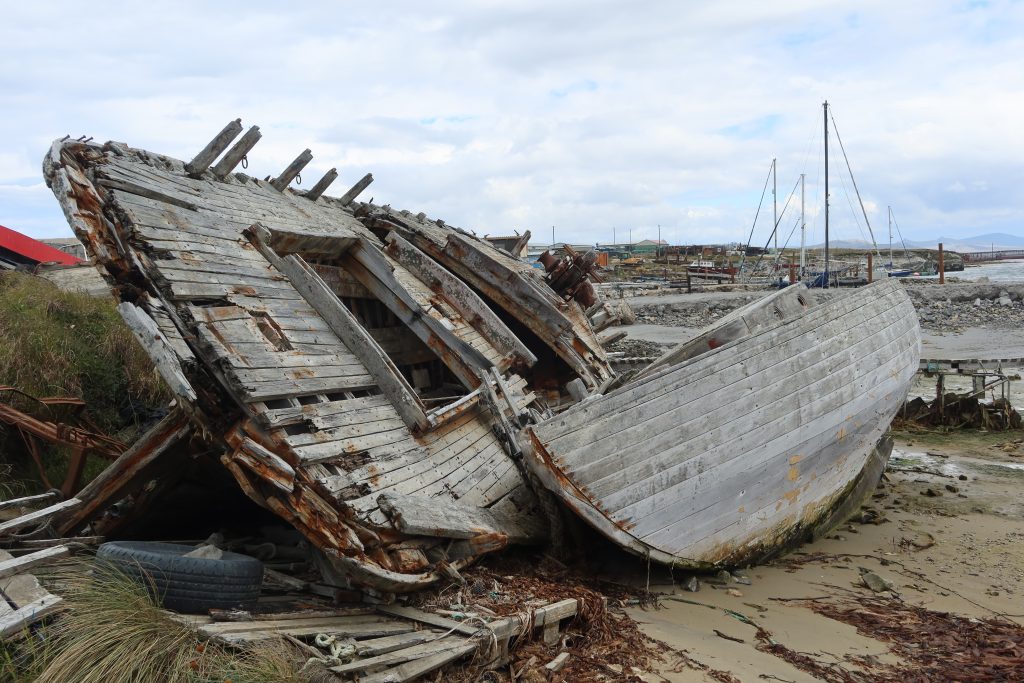
North of the Canache is another shipwreck – the Lady Elizabeth, known locally as the Lady Liz. She now lies in the appropriately named Whalebone Cove and arrived there unintentionally having broken her moorings in the storm. At the time she was in fact just being used as a storage hulk – a fate that awaited many ships as they pulled into Stanley badly damaged after rounding Cape Horn. If the cost of the repairs was too great, then they were just sold for scrap and frequently used as hulks or to create jetties. This was the fate of the Lady Elizabeth in March 1913, though her situation was compounded by hitting a rock on the way into Stanley! She was towed in by a steam tug called the Samson, a tug which is now wrecked just round the corner from the Lady Elizabeth.
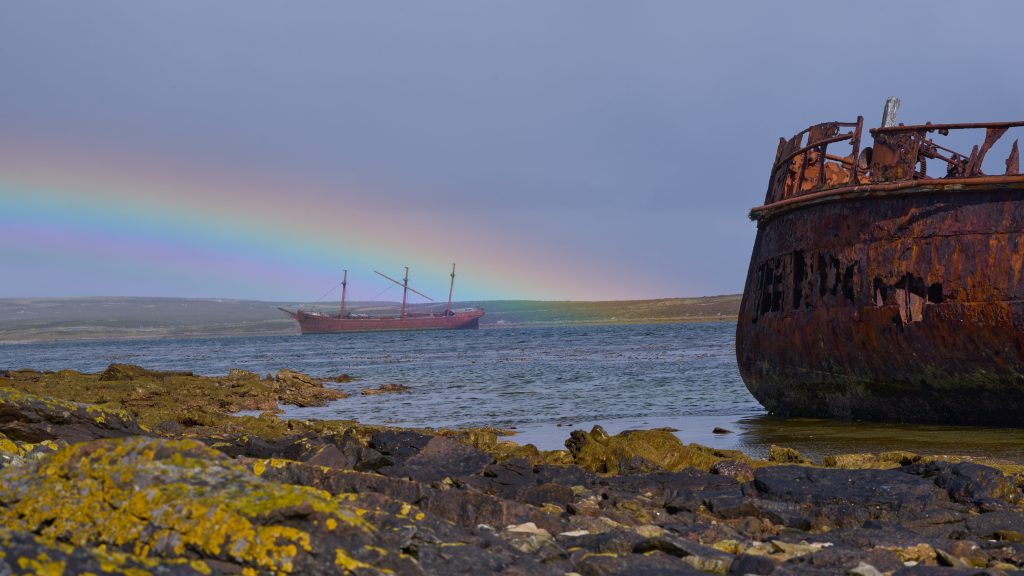
As you walk along the road to the west of Stanley there is another wreck – the Jhelum. She met her end in a similar way to many others in 1870. She was probably overloaded and struggled into Stanley after rounding Cape Horn. She was condemned and left as a hulk. In 2008 she was effectively condemned again – pronounced dangerous and further dismantled. In her prime she was a 428’ barque. She is now a 42.8’ pile of bark …..
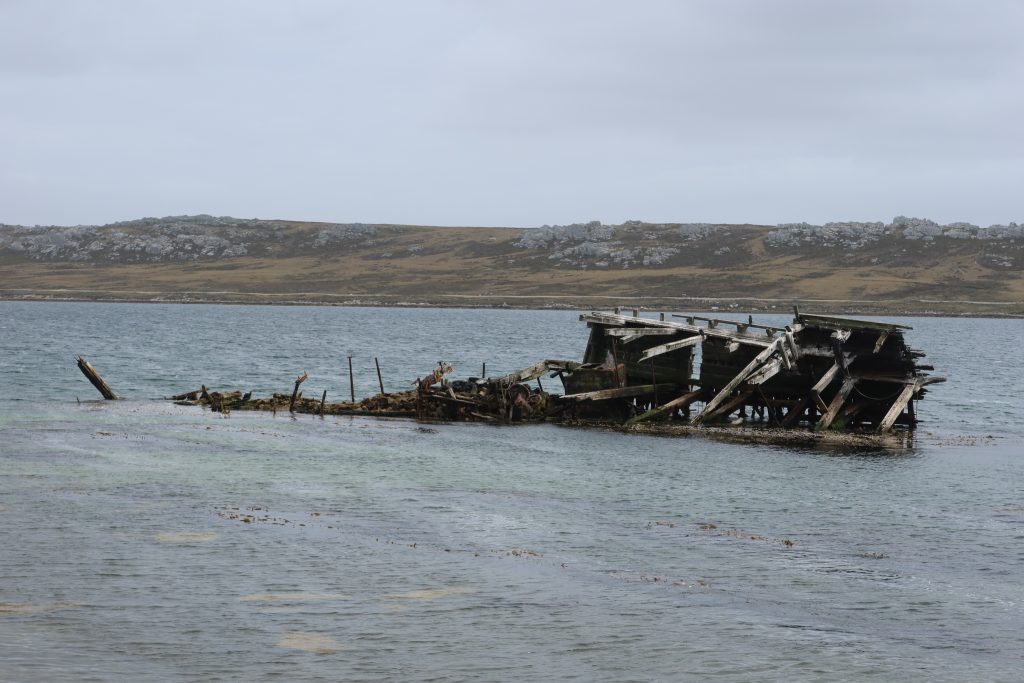
December 6th
Today three of us booked a 4WD trip to Volunteer Point. We had been told we would see penguins there, so it was a no-brainer really. We were warned that it was an off-road trip. I expected this to mean a gravel or earth track of some sort, so was slightly surprised to find that it really was off-road. Our driver Nobby explained that he had his small wheels on because the conditions were really good – my perception was different! When he drove along a beach and said that the other drivers didn’t like using this route because of the quicksand I just started trying to think happy thoughts ….. However, we got there fine (it turned out he had done it nearly 1,000 times!). The sight greeting us was stunning – penguins everywhere. Not just a few, but loads and loads and loads and …. We were warned to stay outside the white stone circles as these marked the breeding areas, but the penguins didn’t take much notice of the white stones either – apart from one penguin who we christened Tom (after Tom Cruise) as he was so short that he stood on the white stones to increase his self-esteem.
There were three types of penguins – King penguins (Aptenodytes Patagionicus), Magellanic penguins (Spheniscus Magellanicus) and Gentoo penguins (Pygoscelis papua). The King penguins are the cutest and appropriately the biggest of the three. They lay one egg between November and March. This is incubated by both parents and takes 55 days to hatch. In the early days both parents tend the chick, but in the winter (April to August) they abandon it and head off to sea returning a lot less frequently. Chicks can lose up to 50% of their body weight over this period. In October/November the parents return to carry on feeding them and the chicks start to moult. The chicks will head off in November/December once they have moulted and they are then on their own. The adults are knackered after all this, so they take a year off and then lay another egg the following year, so they only raise two chicks every three years. Adult King penguins can dive up to 300 metres to catch their prey (small fish (myctophids) and squid) and will spend a large proportion of their lives at sea.
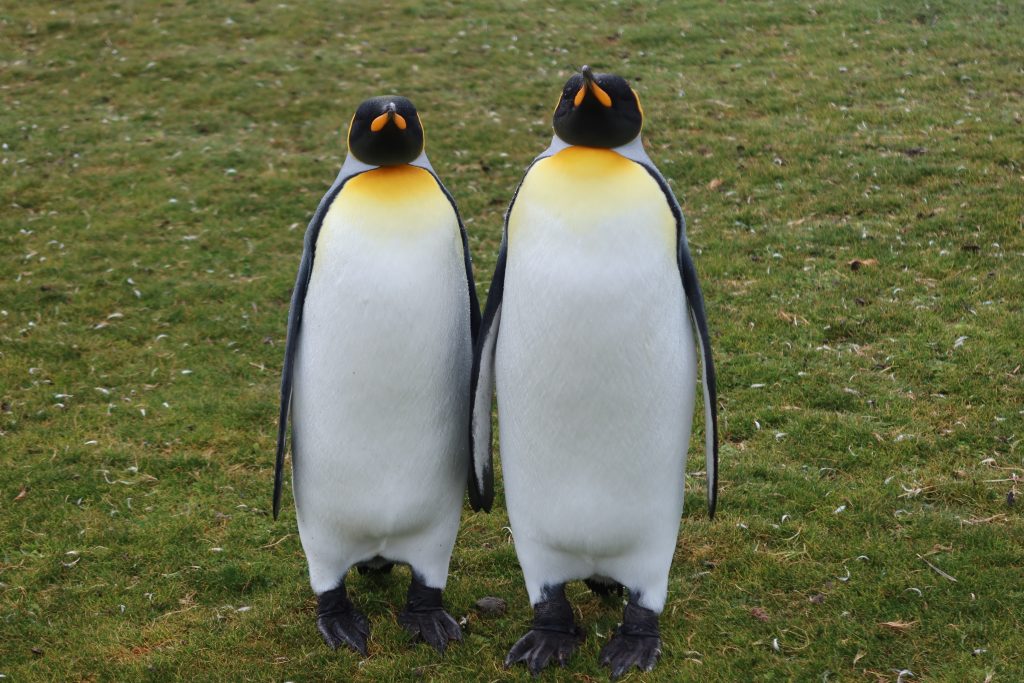
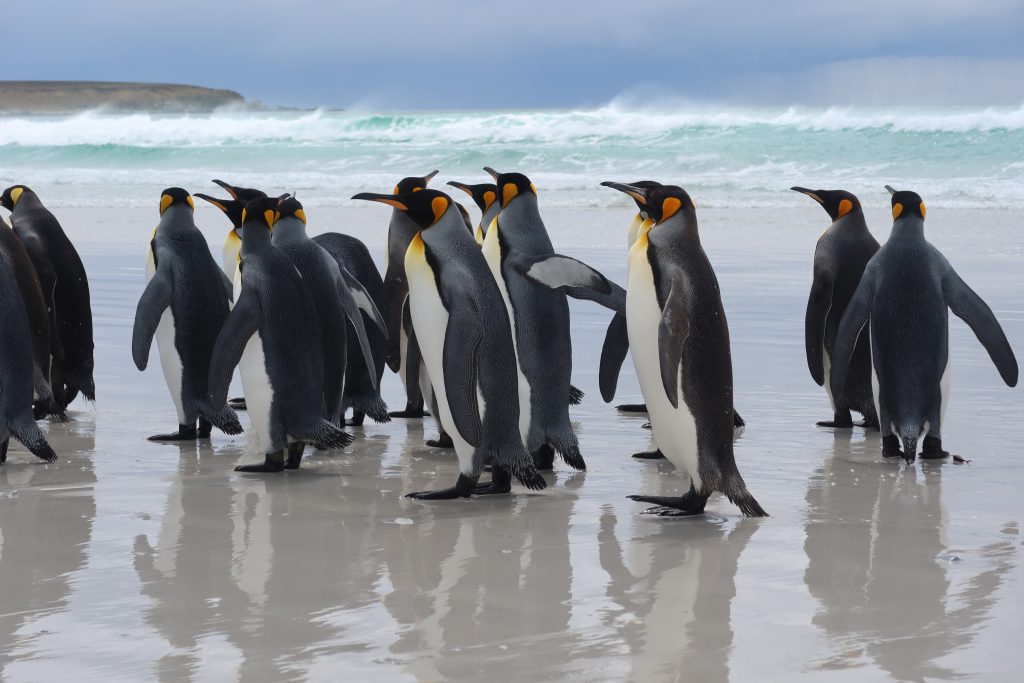
The Gentoos are slightly different. They build a nest from a local plant called the Diddle-Dee and will generally lay two eggs. When the chicks are 3-4 weeks old they form into crèches. Eventually they will start heading down to the shoreline waiting for their parents to feed them. However, the parents don’t make this easy and the chicks do what is called the ‘chick chase’ where they chase their parents to get food from them. It is thought that this strengthens the chicks and helps encourage them into the water to feed for themselves. They usually do this in late February.
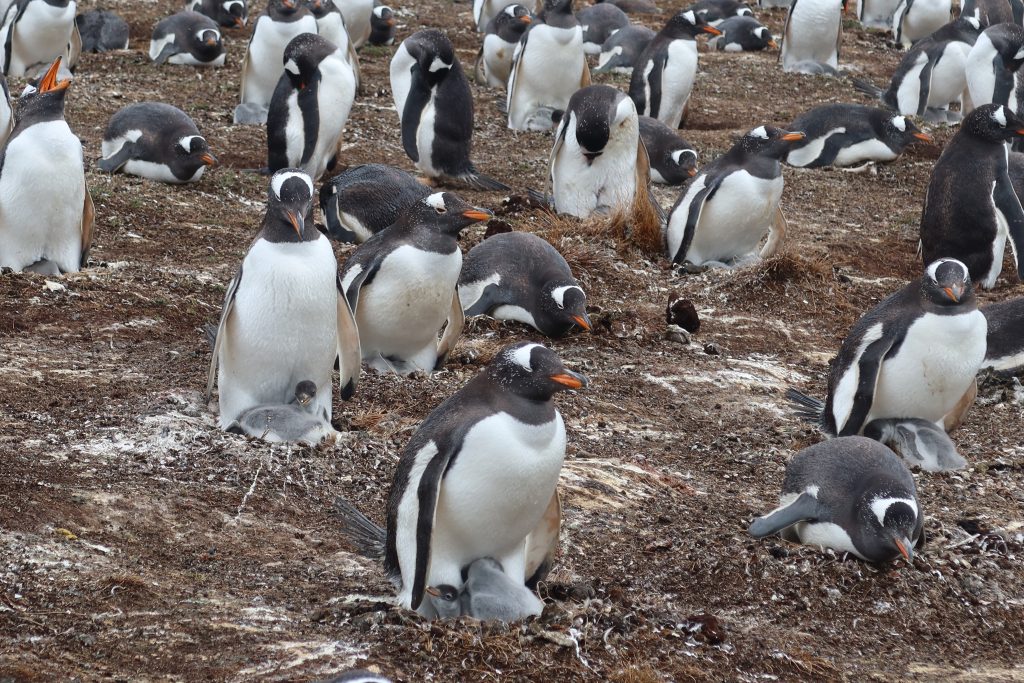
Magellanics are the shyest and they build burrows in the dune areas. These can be up to six foot long and they will reuse them year after year – always good to recycle. On Volunteer Point there are thought to be somewhere around 2,500 breeding pairs and they seem to be flourishing.
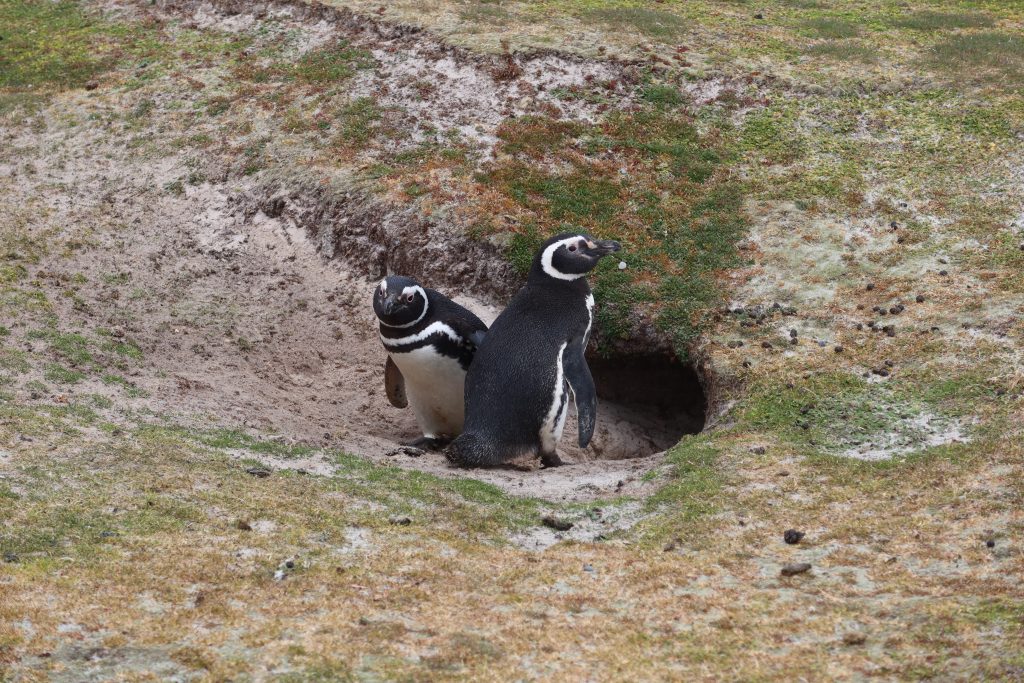
For all the penguins their main predators are seals, skuas and the local vultures. One of these was feeding on a carcass of some sort on the beach …..
December 8th
Today is a holiday in the Falklands. It is known locally as Battle of the Falklands Day. Having immediately assumed that this related to the 1982 conflict, I quickly realised that in fact this relates to the First World War. On December 8th 1914 a German squadron of eight ships under Admiral Graf Maximilian von Spee attempted to raid the coal depot in Stanley, not realising that there was a British squadron coaling around the corner. The British pursued them and within a day had overwhelmed them and sunk the Scharnhorst and five others. The British suffered only very lightly. The wreck of the Scharnhorst was discovered in 2019 at a depth of 1,600 metres.
At 11am at the memorial there was a parade and service remembering the battle. With a number of the Falkland Islands Defence Force and lots of veterans present it was an interesting spectacle. The Governor of the Islands was in full dress with feathers in her hat and the works.
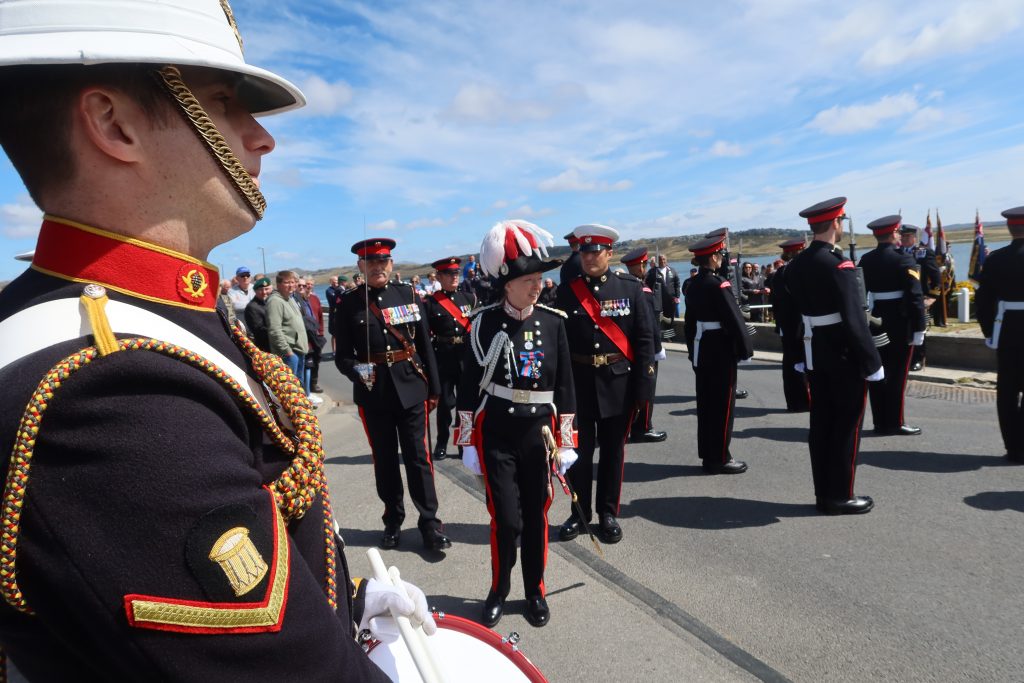
Also present were the Mayors of Whitby and Portsmouth – they are both twinned with Stanley. We knew they were there because our off-road driver from a couple of days before had told us that he was taking them out to Volunteer Point the next day. So, I bounced up to them to ask them how they had enjoyed their trip to Volunteer Point. They were slightly floored by this and seemed to wonder if they were being spied on, but using their well-honed political and diplomatic skills (!!) they recovered quickly and we had a nice chat. I even got given a small pin badge by the Mayor of Whitby, saying that I had met her …..
One of the connections between Whitby and Stanley is that they both have a Whalebone Arch. The one is Stanley was erected in 1933 to mark 100 years of British administration of the islands. It is made up of two pairs of large jawbones from Blue Whales. The arch is 21 foot high, but 3 foot of the bones is in the ground, so these jaws were 24 foot long and they weigh around half a ton each. The Whitby one can’t match this and in fact the current Whitby arch is the third one because the previous two had deteriorated too much. The current one is just 15 foot high (6 foot shorter than the Stanley one!) and dates from 2003. It is the jawbones of a bowhead whale killed by Alaskan Inuits. It was unveiled in 2003 by Miss Alaska …..
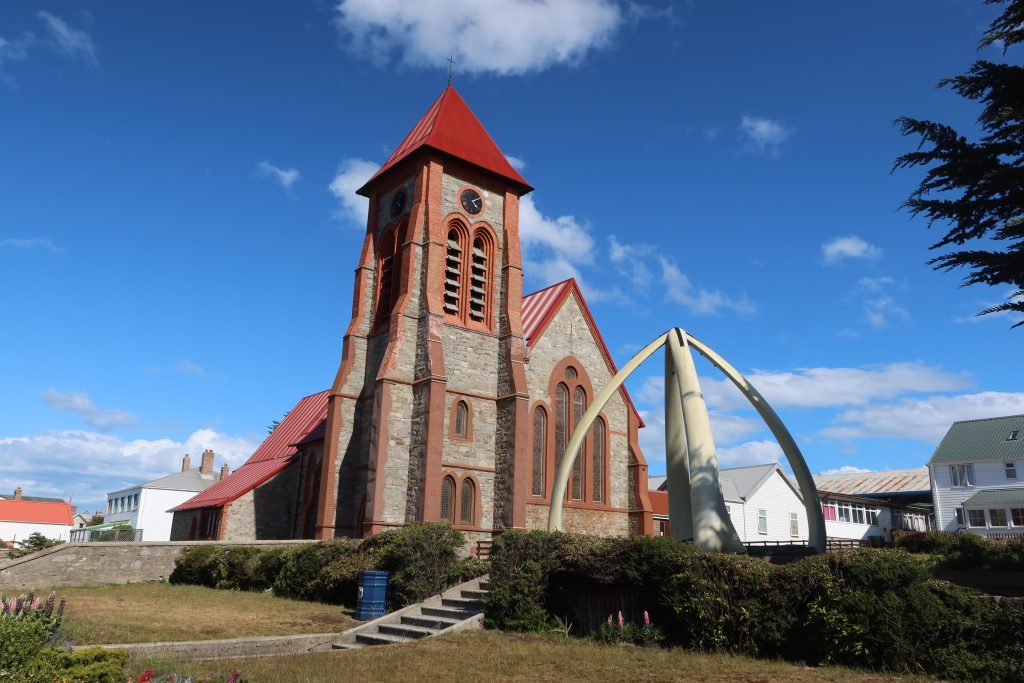
December 9th – 13th
After a quiet day around town I said final goodbyes to the Dutch crew who were leaving in the Rose Tavern while watching the Netherlands vs Argentina match. Not surprisingly the people in the pub were supporting the Netherlands – there may be some history …. However, it didn’t end well for the Dutch.
I headed back to Tecla to meet the new crew for the next passage. Various issues (including Covid) meant that we were slightly reduced in number with five guests and four crew – a total of nine. The final crew member though didn’t arrive until the 10th on a delayed flight from Santiago. Along with him arrived belatedly some parts for the anchor. To help keep the anchor chain in the gypsy when the windlass is hoisting and lowering it they had ordered two new sheaves (or chokers). These direct the anchor chain from the hawse pipe and ensure the right angle for the chain when it is coming on and off the gypsy. However, we had something of a delay while we waited for these to be welded to a new plate on the deck.
On one of the days we got a taxi out to Gypsy Cove via Cape Pembroke lighthouse and then walked back via Engineer Point to Stanley. The three crew I did this with were all passionate photographers and this gave me a totally different perspective on the walk from when I did it previously. We were stopping constantly to find the best angles for photographs and with one of them being an Australian Parks guide as well we spotted a lot more flora and fauna. So a walk which took me two hours previously took over four hours. We did also shelter from a hailstorm which came over, but this was very opportune as it meant a rainbow over the wreck of the Lady Elizabeth just as we came up to it – a great photo opportunity.
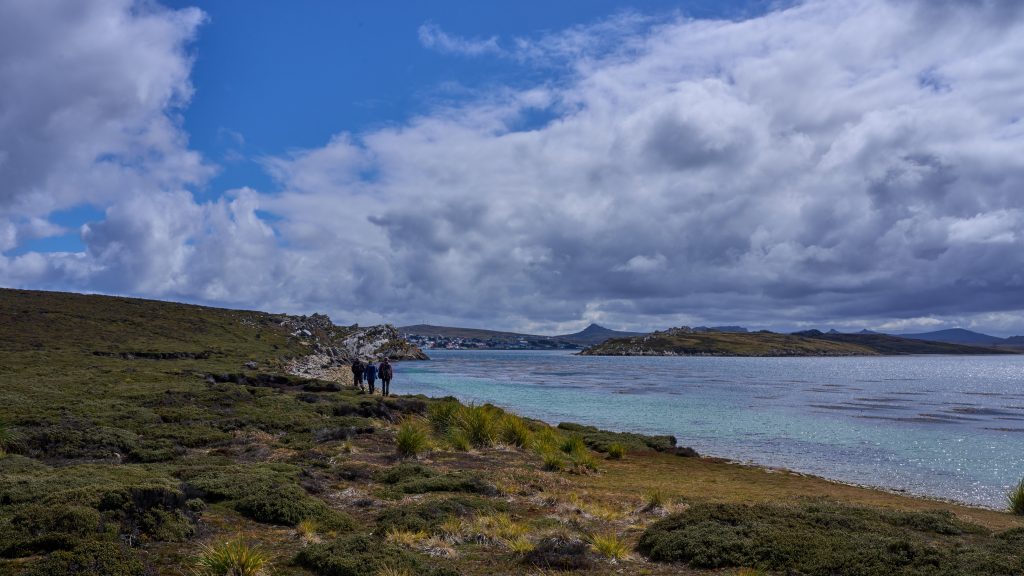
So, on the 12th a few of us booked a trip around Kidney Cove. This was again a 4WD tour (everything on the Falklands is!) and was done by the farmer who owned the land. They raised mainly sheep on 10,000 acres (apparently quite a small farm round here) along with a few cattle for milk and meat. He though had also built a tourist business taking people around the penguin colonies on the farm. These were very varied and the first stop was at a colony of hundreds of rockhopper penguins. The reason for the name was obvious. The colony was at the top of a quite high cove on a rocky outcrop and the penguins hopped up and down to the water with an agility that belied their slightly rotund appearance. Watching them was fascinating with their almost 1980s looking hairstyle – yellow hairs falling down either side of their head. These hairs are apparently called quills. In amongst the colony were two penguins with a bit of an identity crisis. Rather than yellow quills, these had much longer orange quills and rather than being mutant rockhoppers were actually another species of penguin who had clearly lost their way – macaroni penguins. Perhaps they just thought they were a trendier pair of rockhoppers and joined the colony to give the rockhoppers an inferiority complex!
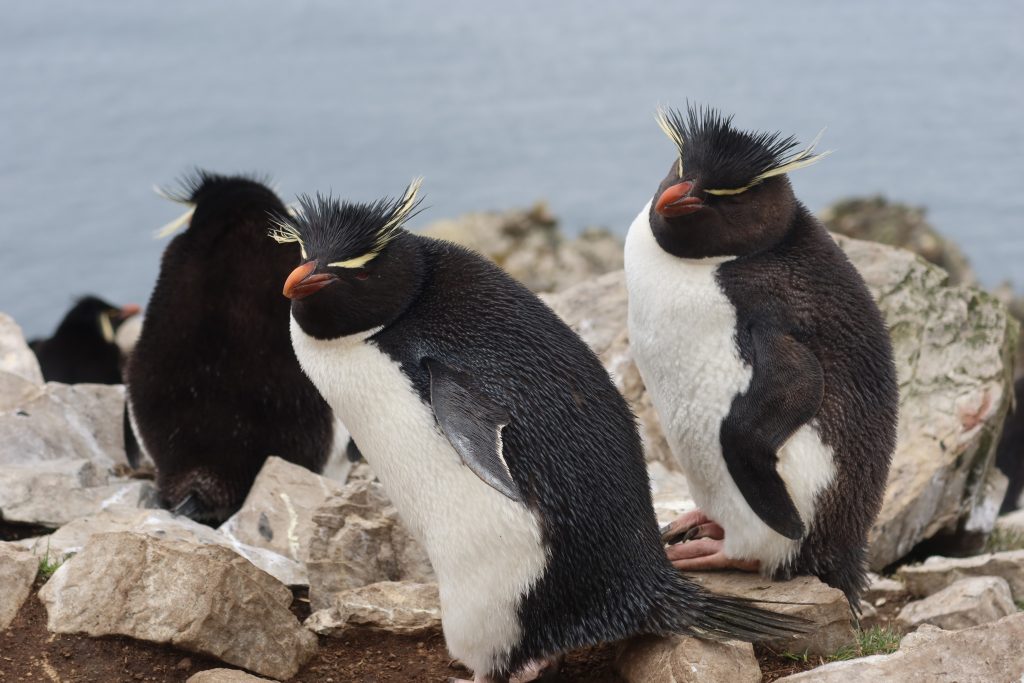
From there we went to another colony of rockhoppers with what initially looked like black and white penguins who could fly. However, they were rock shags nesting in amongst the penguin colony. Seeing them landing in amongst the penguins was slightly surreal and did occasionally cause some agitation amongst the rockhoppers when their aim was not that good. They were nesting and incubating eggs whereas most of the rockhoppers already had some quite well grown chicks.
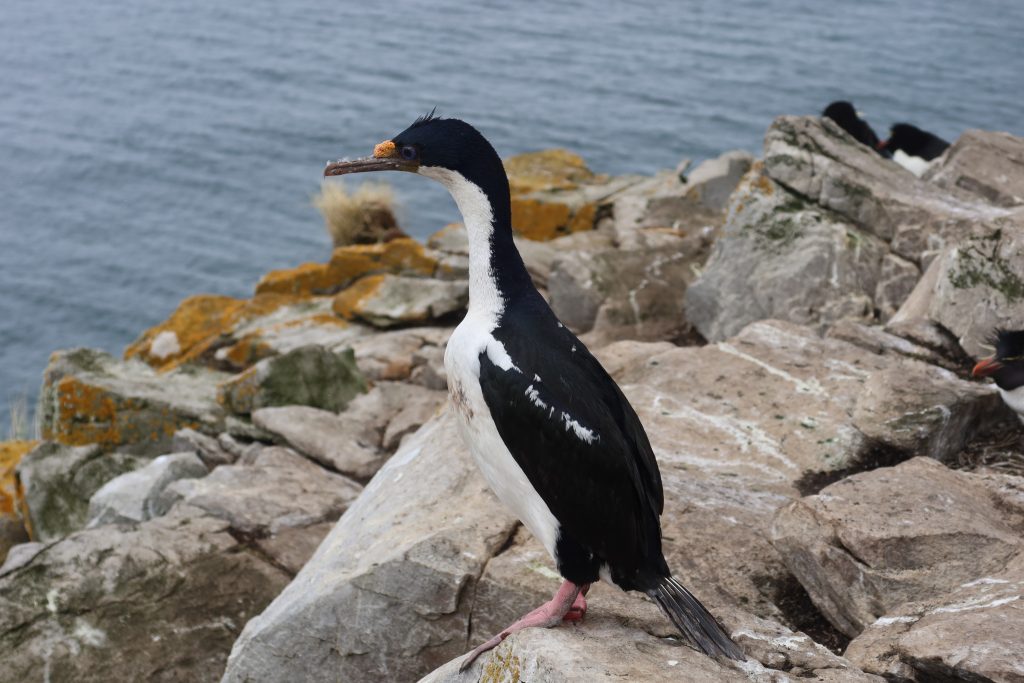
We also saw several gentoo colonies and spent quite a bit of time watching them marching from the beach to their colonies at Kidney Cove and Kidney Beach. The rest of the trip took us past Sparrow Cove where the SS Great Britain was kept as a hulk until she was moved back to Bristol in 1970 and then past a small king penguin colony and finally back to Stanley – a great trip.

